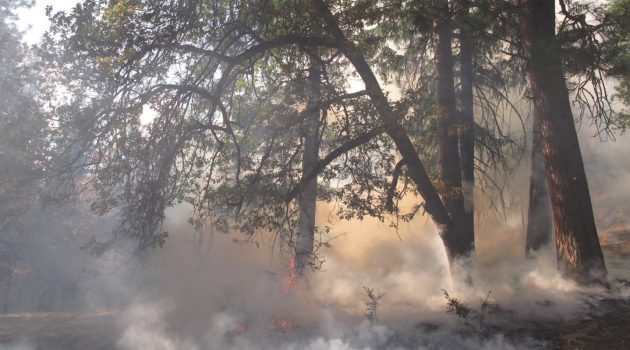Reposted with permission from the Fire Adapted Communities Learning Network
I recently found myself venting about the idea of “nature.” The concept has always bothered me. There's an inherent separatism in it—an implicit line in the sand between humans and nature, where we can and should appreciate it, but we think we aren't really part of it.
I struggle with these ideas often in my work. I've had people question the naturalness of frequently burned landscapes if they know that humans had a role in ignitions—even if human ignitions extend thousands of years into the past. The dichotomy runs deep.
So it's always refreshing to see

scientific reinforcement of what I know in my heart to be true: people are a part of the landscape—a very powerful part.
This is the theme of a recent paper by Alan Taylor, Valerie Trouet, Carl Skinner and Scott Stephens in the Proceedings of the National Academy of Sciences (PNAS). The paper looks at California's Sierra Nevada over the last 400 years, and it finds that socioecological change—human activity—has been the primary driver of changes in the region's fire regimes, more so even than climate.
The paper, which came out late last year, incorporates a unique blend of fire history and human history. The authors were able to reconstruct a 415-year fire record for the region using a combination of tree ring studies and 20th century data on annual area burned. From there, they calculated a “fire index” for every year since 1600—basically a metric that combines fire occurrence and extent, and tells us how much fire activity was going on during that time. Those indices were used to identify large-scale shifts in regional fire regimes, which the authors compared with patterns of human settlement and management, and with climate.
The authors identified four major fire regime periods since 1600, which they were able to link to patterns of human activity. The first regime shift occurred in 1776, triggering a 90-year period of enhanced fire activity. During that period, the mean fire index was almost twice what it had been before 1775. The paper shows that this regime shift was coincident with the timing of Native American contact with Spanish missionaries in the region, which occurred in 1769. It's not exactly intuitive, but the authors explain that the decimation of Native Americans—and a subsequent reduction in light burning—allowed for an increase in fuel continuity and wildfire activity during that period. This connection is further evidenced by the increased sensitivity of fire activity to climate—a relationship that was relatively weak when Native Americans were conducting widespread burning.
The second regime shift occurred in 1866, at which point fire activity dropped back to pre-1776 levels. The authors attribute this shift to major land use changes across the region—mostly associated with intensive livestock grazing, which denuded herbaceous vegetation and had notable effects on fuel continuity and fire spread. During this period, fire activity was also less sensitive to climate than it had been during the previous period because of a lack of fuels.

Credit: Lenya Quinn-Davidson, Fire Adapted Communities Learning Network. Hayfork, where Lenya grew up, has been an epicenter of fire activity in recent decades. It's also been the focus of fire history studies by Alan Taylor and Carl Skinner, who co-authored this new paper.
The third shift is the one we're all most familiar with: the beginning of the fire suppression era in the early 1900s. During the fire suppression period, in which we're still operating today, fire activity has been 4–8 times less than in any other period in recent history. Likewise, the fire-climate relationship has been weak for most of this period; the 20th century has shown increased warming trends, yet fire activity has largely been squelched by human activity. Only in recent decades have we seen a strengthening of that relationship, as a perfect storm of high fuel accumulations, longer fire seasons and drier conditions enables fires of unprecedented severity and size, appearing to override the moderating effects of human management.
My last statement should give us pause. Are we entering an era—perhaps a new fire regime period—where changes in climate are overwhelming our human capacity to influence our landscape? The work of Westerling and others (check out my first Science Tuesday blog from last February) would indicate that we're headed in that direction.

Figure 2 from Taylor et al., 2016: “Regime shifts in time series (1600-2015 CE) of Sierra Nevada fire index, summer moisture (i.e., PDSI), and summer temperature (i.e., WANT). A switch to new regime (fire or climate) is shown by a vertical line … The number of tree-ring sites recording fires in each year for the 1600-1907 CE period shown by a dashed line. The fire regime periods are indicated by color shading: 1600-1775 CE (green), 1776-1865 CE (orange), 1866-1903 CE (blue), and 1904 CE to present (pink).”
But the really valuable thing about this new paper by Taylor et al. is that it gives us a larger context to work within. Yes, recent decades have had increased fire activity and increased sensitivity to climate—we've all seen it. But let's remember that our collective frame of reference is relatively short; for most of us, our vision of what's natural or normal in terms of fire comes from the mid to late 20thcentury—the height of our fire disconnect. This paper allows us to look back and see that the human relationship to fire is enduring and powerful, and that our biggest mistake in the last century has been to deny ourselves that intimacy—to value “nature” over nurture. History tells us that we should be able to buffer climate effects, but only if we actively engage at a grand scale. I think we're ready.
Reference:
Taylor, A. H., Trouet, V., Skinner, C. N., & Stephens, S. (2016). Socioecological transitions trigger fire regime shifts and modulate fire–climate interactions in the Sierra Nevada, USA, 1600–2015 CE. Proceedings of the National Academy of Sciences, 201609775.